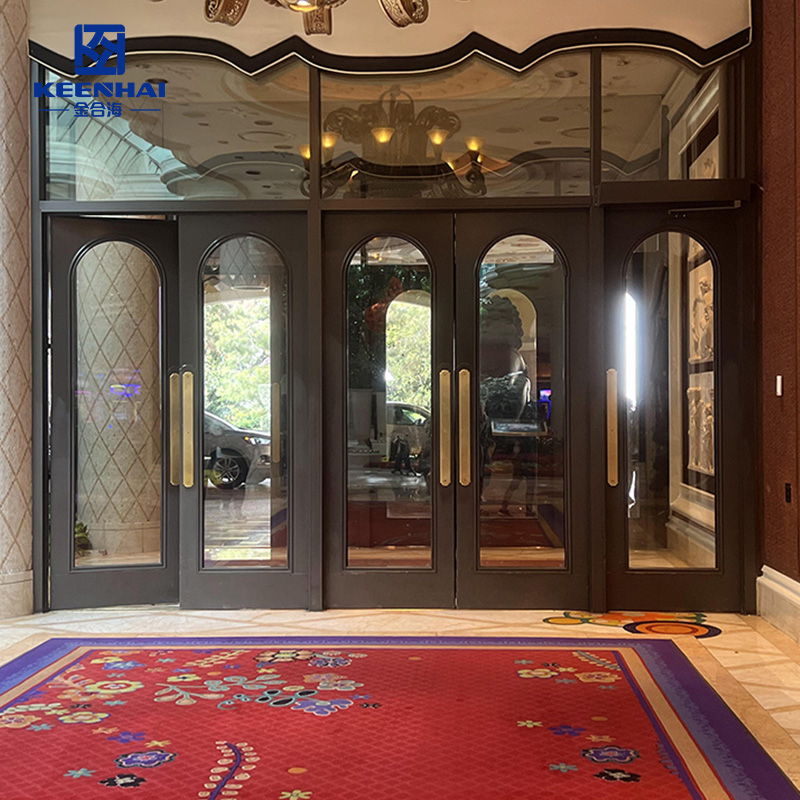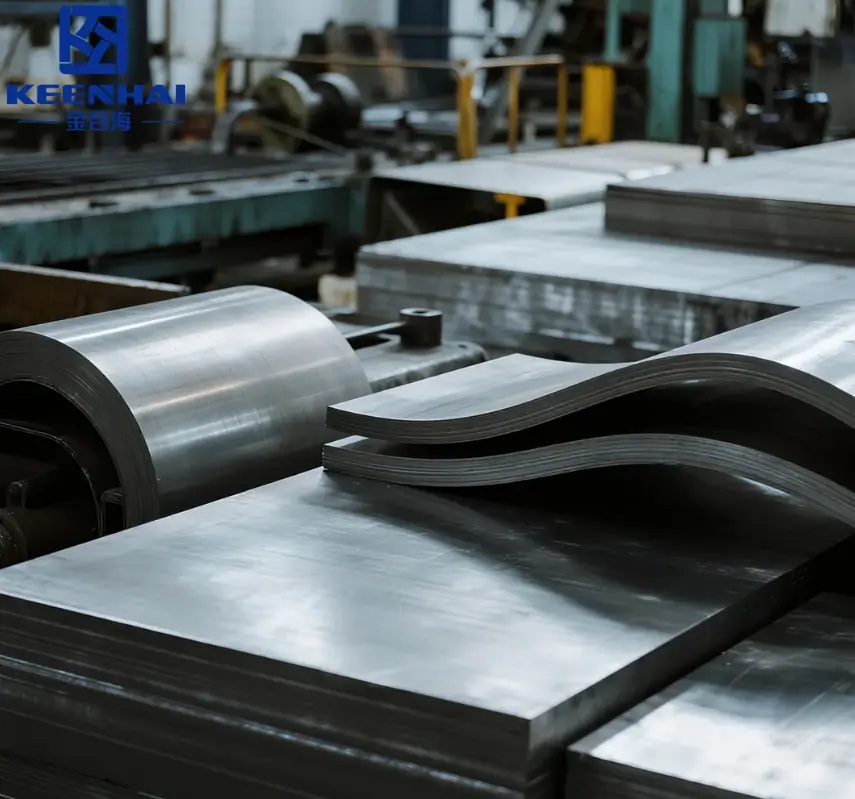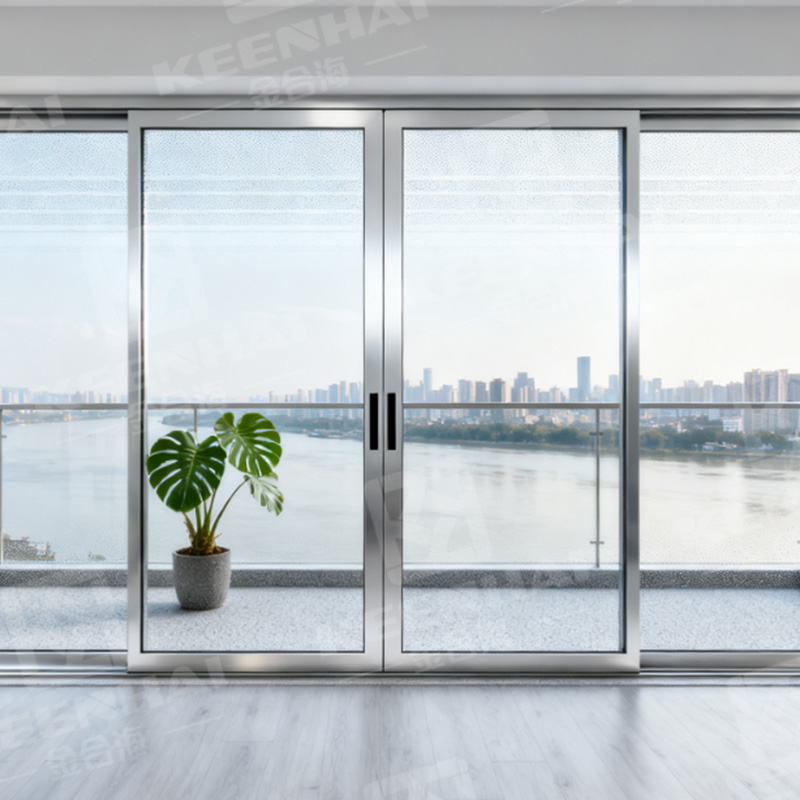Stainless steel glass doors provide strength, transparency, and longevity. Using SUS 304 or 316 steel frames prevents corrosion in humid or coastal areas, while tempered or laminated glass enhances safety and sound insulation. These doors also maintain brightness and create a more open, modern feel, making them ideal for commercial lobbies, hotels, and residential projects where durability and visual appeal are both critical.
1.Why Choose Stainless Steel Glass Doors
Choosing stainless steel glass doors isn’t just about aesthetics—it’s a decision driven by engineering logic, durability data, and real-world performance. These doors are widely used in commercial buildings, hotels, airports, and modern villas, where transparency, safety, and long-term stability matter.
In large architectural projects, stainless steel glass entry systems outperform aluminum or wood-framed alternatives by a wide margin. Tests show that SUS 304 and SUS 316 frames resist corrosion up to 10× better than coated aluminum, especially in humid or coastal environments. When combined with 10–12 mm tempered or laminated glass, they achieve an impressive sound reduction of 32–35 dB and withstand impact forces over 1000 N, meeting international safety standards for public buildings.
| Feature | Stainless Steel Glass Doors | Aluminum-Framed Doors |
|---|---|---|
| Corrosion Resistance | Excellent (SUS 304/316) | Moderate |
| Maintenance Frequency | Once per 18–24 months | Every 6–12 months |
| Structural Lifespan | 25–30 years | 10–15 years |
| Recyclability | 100% | 70–80% |
| Aesthetic Durability | Retains finish for decades | Fades or peels over time |
Beyond numbers, these doors enhance spatial brightness by up to 25%, allowing architects to visually connect interior and exterior spaces. For instance, in the Shanghai Hongqiao Business District, the main lobby of a corporate tower features a brushed stainless steel entrance door that reflects natural light during the day and complements granite facades at night. This blend of strength, modernity, and elegance is exactly why stainless steel glass systems dominate high-end architectural design.
They are also flexible in configuration—swing-type entrance doors for office lobbies and sliding versions for commercial storefronts or residential patios. A well-designed stainless steel entrance door delivers presence and security, while a stainless steel sliding door optimizes space and accessibility without compromising strength.
Ultimately, architects choose stainless steel glass assemblies not only for their resilience but also for their timeless minimalism—clean lines, reflective finishes, and superior material integrity that make a statement in any building.

2.Key Design Considerations
When choosing a stainless steel glass door, the design phase is where most long-term value is determined. Every architectural project—whether a luxury villa, hotel lobby, or retail storefront—demands a unique balance between functionality, proportion, and finish quality. Ignoring these details early often leads to maintenance issues or visual inconsistencies later.
2.1 Material Grade and Frame Structure
The steel grade directly affects corrosion resistance and longevity. SUS 304 is suitable for interior use or mild climates, while SUS 316 should be the default choice for coastal or high-humidity projects. Frame thickness typically ranges between 1.2–2.0 mm, depending on door height and glass weight. For a 2400 mm-high entry door with 12 mm glass, the frame should not be thinner than 1.5 mm to ensure rigidity during wind pressure tests (up to 700 Pa). Choosing precision-welded joints over mechanical fasteners helps maintain alignment and prevents rattle during repeated opening cycles—especially important in high-traffic commercial entrances.
2. 2Aesthetic Finishes and Hardware Compatibility
Finish consistency defines perceived quality. Brushed and mirror-polished surfaces dominate contemporary architecture, while PVD-coated options are now preferred for projects seeking color durability and design distinction. Data from facade engineering surveys show that PVD stainless surfaces retain over 95% of their original gloss after 5 years of outdoor exposure, compared to roughly 70% for standard brushed steel. High-traffic areas like hotel entrances or corporate lobbies often pair these finishes with hydraulic hinges, soft-closing floor springs, and concealed handle systems for smooth operation and cleaner lines.
A good example is a commercial tower in Shenzhen, where a double-swing stainless steel glass entrance system was custom-fabricated with bronze PVD coating. After three years of continuous use, the surface still shows no oxidation or discoloration—proving that high-grade stainless finishes are not just decorative but structurally protective layers.
2.3Integration with Building Envelope
Proper design means coordinating with façade materials and door surroundings. For stone-clad or glass curtain walls, the frame reveal depth must align within ±3 mm tolerance to maintain a flush surface line. This precision not only enhances aesthetics but also reduces air leakage by up to 20%, improving the building’s overall energy efficiency. Partnering with experienced fabricators such as pvdstainlesssteel.com ensures that both frame geometry and hardware are engineered to meet these tolerances.
In the end, great design isn’t about decoration—it’s about precision, endurance, and integration. Every measurement, hinge alignment, and surface treatment decision directly affects how the door performs and looks a decade later.

3.Glass Types and Frame Finishes
Selecting the right glass type and frame finish defines how a stainless steel glass door performs over time—both visually and structurally. These two components determine energy efficiency, safety rating, maintenance frequency, and the entire architectural tone of the entrance.
3.1Glass Specification and Performance
Most architectural projects rely on tempered or laminated safety glass ranging from 10 mm to 12 mm in thickness. Laminated glass, composed of two glass sheets bonded by PVB or SGP interlayers, offers up to 5× the impact resistance of regular tempered glass and remains intact even when shattered. In high-traffic zones like airports or retail malls, laminated options are preferred for both acoustic control (30–35 dB) and anti-burglary resistance.
For interior partitions or moderate-traffic lobbies, clear tempered glass remains a cost-efficient choice, providing clarity and a lighter frame load. For privacy zones—executive offices, spas, or clinics—frosted or tinted glass panels reduce visibility without compromising light transmission.
| Glass Type | Thickness (mm) | Impact Resistance | Acoustic Rating | Typical Application |
|---|---|---|---|---|
| Tempered | 10–12 | 1× | 28–30 dB | Offices, retail stores |
| Laminated (PVB) | 10.76–12.76 | 5× | 32–35 dB | Hotels, airports, hospitals |
| Frosted / Tinted | 10 | 1× | 28–32 dB | Private offices, spas |
| Low-E Coated | 12 | 2× | 30–33 dB | Energy-efficient buildings |
A recent façade study in Singapore found that using low-E laminated glass in ground-floor entrances reduced internal heat gain by up to 18%, lowering annual HVAC consumption costs by nearly $2.5 per square foot—a measurable energy-saving advantage for commercial towers.
3.2Frame Finish and Surface Durability
The frame finish is more than a cosmetic choice—it directly impacts maintenance cost and long-term brand image. Brushed stainless steel provides a matte, architectural look that hides fingerprints, while mirror-polished finishes suit luxury hotels or high-visibility façades. However, for modern developers, PVD-coated stainless steel has become the premium standard.
The PVD (Physical Vapor Deposition) process deposits metal ions—like titanium nitride or zirconium—onto the steel surface, forming a layer three times harder than standard chrome plating. In field tests, PVD coatings maintained color stability above 95% after 10,000 hours of salt spray exposure, while brushed finishes showed early discoloration.
Many architects now specify custom PVD tones such as champagne gold, bronze, or black titanium for luxury commercial projects. One case example is the Shenzhen Futian Central Plaza, where the stainless steel glass entrance door features a brushed bronze PVD finish—resistant to fingerprints and weathering after years of public use.
Ultimately, choosing the right glass and finish combination isn’t about style alone—it’s an engineering decision that affects visual transparency, corrosion life cycle, and operational reliability for decades to come.

4.Cost and Installation Tips
Investing in a stainless steel glass door is not only about visual appeal—it’s a calculated decision involving material, labor, and precision alignment. Prices vary widely depending on glass type, steel grade, and finish. Based on 2025 market data, the average cost ranges from $480 to $950 per square meter, including frame fabrication and on-site installation. Projects using PVD-coated 316 stainless steel and laminated glass panels typically reach the higher end of that range due to material durability and advanced coating processes.
| Component | Material Specification | Average Cost (USD/m²) | Notes |
|---|---|---|---|
| Frame (SUS 304 brushed) | 1.5 mm thickness | 150–200 | Suitable for indoor applications |
| Frame (SUS 316 PVD finish) | 1.8 mm thickness | 220–300 | Ideal for outdoor façades |
| Tempered Glass | 10–12 mm | 120–160 | Standard for interior partitions |
| Laminated Glass | 10.76–12.76 mm | 180–250 | Better soundproofing and safety |
| Hardware & Accessories | Hinges, locks, handles | 80–150 | Quality directly affects durability |
A well-planned project should also consider installation quality, as improper alignment or poor sealing can cause door sagging or air leakage within a year. Below is a simplified yet professional installation workflow followed by most contractors handling stainless steel glass entrance systems in commercial buildings.
Installation Process (Step-by-Step):
-
Site Measurement & Framing Check
Before fabrication, technicians measure the opening dimensions with ±1 mm tolerance. Uneven walls are corrected with leveling mortar to ensure vertical precision. -
Frame Assembly and Alignment
The door frame is positioned using laser leveling tools. Anchors are fixed every 400 mm along the jambs, ensuring the frame sits perfectly square. Stainless steel shims are inserted where micro-adjustments are required. -
Glass Placement and Securing
Once the frame is aligned, the glass panel is carefully lifted using suction clamps. Installers apply clear structural silicone at the contact joints to absorb expansion stress and prevent vibration noise during operation. -
Hardware Integration
Hinges, locks, and handles are installed with torque-controlled tools. For hydraulic floor springs, the pivot axis must align precisely with the glass centerline to ensure smooth motion. -
Final Calibration and Inspection
The installer checks the swing motion, gap uniformity (recommended 3–5 mm), and lock operation. Finally, a protective film is applied to prevent scratches during other construction phases.
A professional team can complete a standard double-leaf stainless steel entrance door installation in 6–8 hours, including calibration and sealing. For large façades with multiple units, an average daily output of 15–20 m² is typical.
To reduce long-term maintenance costs, experts recommend:
-
Cleaning with neutral pH detergent every two months.
-
Avoiding chlorine-based cleaners that cause surface oxidation.
-
Applying nano protective coating once a year for PVD finishes.
Selecting the right stainless steel glass door combines engineering precision, material performance, and architectural aesthetics. From choosing the correct steel grade and glass type to specifying finishes that endure high traffic and harsh climates, every decision affects long-term durability and user experience. Real-world projects—from Shenzhen skyscrapers to Shanghai commercial lobbies—demonstrate that doors crafted with SUS 316 stainless steel and laminated glass not only meet stringent safety standards but also elevate property value and spatial appeal.
Investing in professional installation, calibrated hardware, and quality finishes ensures doors operate smoothly for decades, resisting warping, corrosion, and wear. Developers, architects, and property owners who plan carefully achieve measurable benefits: reduced maintenance costs, improved energy efficiency, and a lasting impression of modernity and quality.
For anyone considering a premium entrance solution, exploring the full range of stainless steel glass doors Stainless Steel Glass Doors on pvdstainlesssteel.com is the next step. With customizable options—swing doors, sliding systems, PVD finishes—and detailed engineering support, you can confidently select doors that match both design intent and functional requirements, ensuring your building stands out while performing flawlessly for years.







